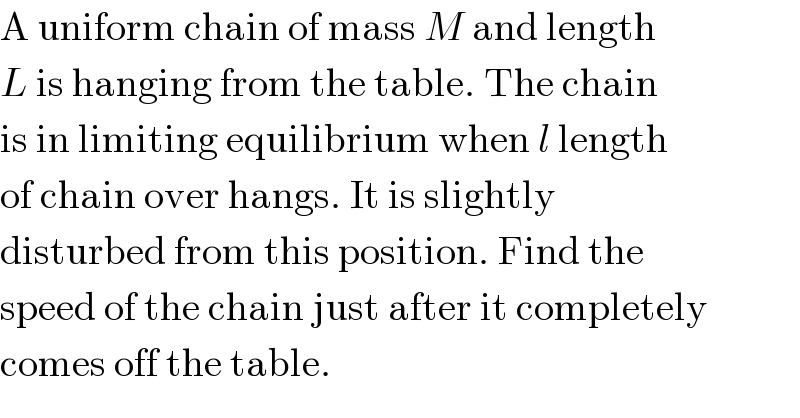
Question Number 23288 by Tinkutara last updated on 28/Oct/17

$$\mathrm{A}\:\mathrm{uniform}\:\mathrm{chain}\:\mathrm{of}\:\mathrm{mass}\:{M}\:\mathrm{and}\:\mathrm{length} \\ $$$${L}\:\mathrm{is}\:\mathrm{hanging}\:\mathrm{from}\:\mathrm{the}\:\mathrm{table}.\:\mathrm{The}\:\mathrm{chain} \\ $$$$\mathrm{is}\:\mathrm{in}\:\mathrm{limiting}\:\mathrm{equilibrium}\:\mathrm{when}\:{l}\:\mathrm{length} \\ $$$$\mathrm{of}\:\mathrm{chain}\:\mathrm{over}\:\mathrm{hangs}.\:\mathrm{It}\:\mathrm{is}\:\mathrm{slightly} \\ $$$$\mathrm{disturbed}\:\mathrm{from}\:\mathrm{this}\:\mathrm{position}.\:\mathrm{Find}\:\mathrm{the} \\ $$$$\mathrm{speed}\:\mathrm{of}\:\mathrm{the}\:\mathrm{chain}\:\mathrm{just}\:\mathrm{after}\:\mathrm{it}\:\mathrm{completely} \\ $$$$\mathrm{comes}\:\mathrm{off}\:\mathrm{the}\:\mathrm{table}. \\ $$
Commented by Tinkutara last updated on 28/Oct/17

Commented by Physics lover last updated on 28/Oct/17

$${Is}\:{it}\: \\ $$$$\:\:\:\:\:\:\sqrt{{g}\left({L}−{l}\right)}\:\:? \\ $$
Commented by Physics lover last updated on 28/Oct/17

$${The}\:{answer}\:{given}\:{in}\:{the}\:{book}\:{is} \\ $$$$\:\:\:\:\:\:\:\sqrt{\frac{{gL}}{\left(\mathrm{1}+\mu\right)}} \\ $$$${ut}\:{the}\:{answer}\:{which}\:{i}\:{got}\:{is}\:{same}. \\ $$$$\: \\ $$$$\mu\:=\:\frac{{l}}{{L}−{l}\:}\:\:\:\:\:\Rightarrow\:{l}\:=\:\frac{\mu{L}}{\left(\mathrm{1}+\mu\right)} \\ $$$${if}\:\:{you}\:{substitute}\:\:{l}\:\:\:{in}\:\:{my}\:{answer} \\ $$$$\:\:\:\:\sqrt{{g}\left({L}−{l}\right)\:} \\ $$$$=\:\sqrt{{g}\left\{{L}−\frac{\mu{L}}{\left(\mathrm{1}+\mu\right)}\right\}} \\ $$$$=\:\sqrt{{g}\left\{\frac{{L}+\mu{L}−\mu{L}}{\left(\mathrm{1}+\mu\right)}\right\}} \\ $$$$=\:\sqrt{\frac{{gL}}{\left(\mathrm{1}+\mu\right)}} \\ $$$$ \\ $$
Answered by Physics lover last updated on 28/Oct/17

$$ \\ $$$$ \\ $$$$\:\:\:\:\lambda\:=\:{linear}\:{mass}\:{density}\:=\:\frac{{M}\:}{{L}} \\ $$$$\:\:\:\Rightarrow\:\mu{g}\left({L}−{l}\right)\lambda\:=\:\lambda{gl} \\ $$$$\:\:\:\Rightarrow\:\mu\:\:=\:\frac{{l}\:}{\left({L}−{l}\right)} \\ $$$$\:\:\: \\ $$$$\:\:\:\:{let}\:{an}\:{element}\:{dx}\:{at}\:{a}\:{distance} \\ $$$$\:\:\:{x}\:{from}\:{edge}\:{of}\:{table}. \\ $$$$\:\:\:{dW}_{{friction}\:} \:\:=\:\left(−\mu{g}\lambda{dx}\right)\centerdot{x} \\ $$$${as}\:{friction}\:'{s}\:{direction}\:{is}\:{opposite} \\ $$$${to}\:{that}\:{of}\:{dist}\:{covered}. \\ $$$$\:\Rightarrow\:\int_{\mathrm{0}} ^{\:\:{W}} {dW}\:=\:\:\:−\:\underset{\mathrm{0}} {\overset{\left({L}−{l}\right)} {\int}}\:\mu{g}\left(\frac{{M}}{{L}}\right){x}\:\centerdot{dx} \\ $$$$\:\:\Rightarrow\:{W}\:=\:−\frac{{Mgl}\left({L}−{l}\right)}{\mathrm{2}{L}} \\ $$$${Using}\:\:{Energy}\:{conservation} \\ $$$$\Rightarrow\:\mid\Delta{K}.{E}.\mid\:=\:\mid\Delta{P}.{E}.\mid\:+\:{W}_{{friction}} \\ $$$$\Rightarrow\:\frac{\mathrm{1}}{\mathrm{2}}\:{mv}^{\mathrm{2}\:} =\:\mid\:{g}\left(\lambda{l}\right)\left(\frac{{l}}{\mathrm{2}}\right)−{g}\left(\lambda{L}\right)\left(\frac{{L}}{\mathrm{2}}\right)\mid\:−\:\frac{{Mgl}\left({L}−{l}\right)}{\mathrm{2}{L}} \\ $$$$\:{subtitute}\:\lambda\:=\:\frac{{M}}{{L}} \\ $$$${on}\:{solving}\: \\ $$$$\:\:{v}\:=\:\sqrt{{g}\left({L}−{l}\right)} \\ $$$$ \\ $$$$ \\ $$$$ \\ $$$$ \\ $$
Commented by Physics lover last updated on 28/Oct/17

Commented by Tinkutara last updated on 28/Oct/17

$$\mathrm{Thank}\:\mathrm{you}\:\mathrm{very}\:\mathrm{much}\:\mathrm{Sir}! \\ $$
Commented by Physics lover last updated on 28/Oct/17

$${you}\:{are}\:{welcome}. \\ $$$${BTW},{did}\:{you}\:{try}\:{question}\:{no}.\:\mathrm{14} \\ $$$$\:{H}\:{section}\:,\:{laws}\:{of}\:{motion}.{Its} \\ $$$${a}\:{good}\:{one}\:{too}. \\ $$
Commented by Physics lover last updated on 28/Oct/17

$${hmmm}. \\ $$$$ \\ $$
